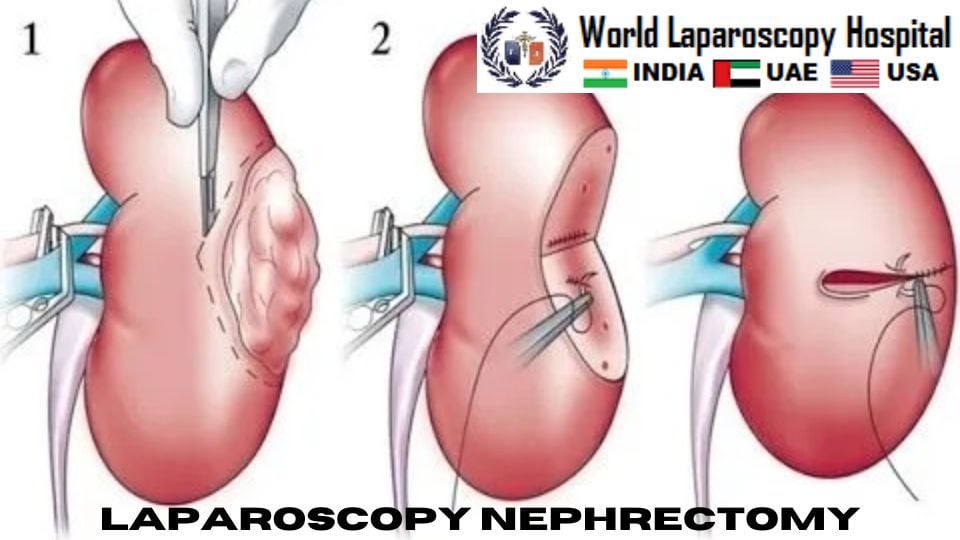This video demonstrate patients diagnosed with a large (i.e., > 4 cm) kidney tumor (Figure 1), laparoscopic radical nephrectomy provides patients with a safe and minimally invasive technique for complete removal of the affected kidney and tumor.
Laparoscopic nephrectomy is a minimally invasive surgical procedure used to remove a kidney using a laparoscope, a thin tube with a camera and light that is inserted into the abdomen through small incisions. Laparoscopic nephrectomy is typically used to treat conditions such as kidney cancer, benign kidney tumors, or severe kidney disease.

The procedure is performed under general anesthesia, and typically involves the following steps:
-
Small incisions are made in the abdomen, through which the laparoscope and other surgical instruments are inserted.
-
The surgeon uses the laparoscope to visualize the kidney and identify the blood vessels and ureter that supply it.
-
The blood vessels and ureter are clamped and cut, and the kidney is detached from the surrounding tissues.
-
The kidney is removed through one of the small incisions.
-
The incisions are closed with sutures or surgical staples.
Complications associated with laparoscopic nephrectomy can include bleeding, infection, injury to nearby organs, or damage to the remaining kidney. The risks and benefits of laparoscopic nephrectomy should be discussed with the patient prior to the procedure, and the patient should be monitored closely during and after the surgery for any signs of complications.
Overall, laparoscopic nephrectomy is a safe and effective option for the surgical management of kidney conditions, offering several advantages over traditional open surgery, including less pain, smaller scars, and a shorter recovery time. However, as with any surgical procedure, there are risks and potential complications that should be carefully considered before proceeding with the surgery.
Laparoscopic nephrectomy is a minimally invasive surgical procedure used to remove a kidney. The advantages of laparoscopic nephrectomy over traditional open surgery include:
-
Smaller Incisions: Laparoscopic nephrectomy requires only a few small incisions (typically 3-4) compared to the large incision required for open surgery. These smaller incisions reduce scarring, decrease postoperative pain and discomfort, and result in a shorter recovery time.
-
Reduced Blood Loss: The laparoscopic approach involves less surgical trauma to the tissues, which results in less blood loss during the procedure. This reduces the need for blood transfusions and lowers the risk of complications related to blood loss.
-
Faster Recovery: Laparoscopic nephrectomy is associated with a faster recovery time compared to open surgery. Patients are usually able to return to normal activities within a few weeks after the procedure.
-
Lower Risk of Infection: With smaller incisions and less tissue trauma, the risk of infection is significantly lower with laparoscopic nephrectomy.
-
Better Cosmesis: The smaller incisions used in laparoscopic nephrectomy result in better cosmetic outcomes compared to open surgery, as the scars are smaller and less visible.
Overall, laparoscopic nephrectomy is a safe and effective alternative to open surgery for the removal of a kidney, and offers numerous advantages for patients.
Although laparoscopic nephrectomy is generally a safe procedure, like any surgery, it does carry some risks and potential complications. Some of the possible complications associated with laparoscopic nephrectomy include:
-
Bleeding: As with any surgery, there is a risk of bleeding during and after the procedure. In rare cases, this may require a blood transfusion or further surgery.
-
Infection: Laparoscopic nephrectomy carries a small risk of infection, which may require antibiotics or further treatment.
-
Damage to nearby organs: During the procedure, there is a small risk of damage to nearby organs, such as the bowel or major blood vessels.
-
Nerve damage: Laparoscopic nephrectomy may cause nerve damage, which can lead to numbness, weakness, or pain in the affected area.
-
Hernia: In rare cases, a hernia may develop at the site of one of the incisions used for the laparoscopic procedure.
-
Conversion to open surgery: In some cases, laparoscopic nephrectomy may need to be converted to open surgery due to unforeseen complications or difficulty during the procedure.
It is important to discuss the risks and potential complications of laparoscopic nephrectomy with your doctor before undergoing the procedure. Your doctor will be able to assess your individual risk factors and provide you with personalized information about the potential risks and benefits of the procedure.
| Older Post | Home | Newer Post |




